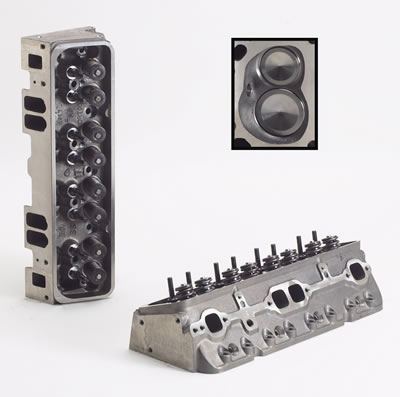firstgear
Well-known member
- Joined
- Oct 11, 2003
- Messages
- 1,895
- Location
- Norwalk, Ohio
- Corvette
- 15 Z06, 01 Vert, 63 SWC & 60 ALL RED
one of the intake manifolds I am considering for my '60 vette only works with Vortec style heads. I have a mid 70's 350cuin motor that has been turned into a 383 stroker with stock heads.
I have found some Vortec heads at Summit

Brand: Summit
Product Line: Summit Performance Vortec Cylinder Heads
Cylinder Head Style: Assembled
Cylinder Head Material: Cast iron
Cylinder Head Finish: Natural
Combustion Chamber Volume (cc): 67
CNC Machined Combustion Chamber: No
Intake Runner Volume (cc): 170cc
CNC Machined Intake Runner: No
CNC Machined Exhaust Runner: No
Intake Port Location: Standard
Exhaust Port Shape: Square
Exhaust Port Location: Standard
Spark Plug Style: Straight
Intake Valves Included: Yes
Intake Valve Diameter (in): 1.940 in.
Exhaust Valves Included: Yes
Exhaust Valve Diameter (in): 1.500 in.
Valve Springs Included: Yes
Maximum Valve Lift (in): 0.520 in.
Outside Diameter of Outer Spring (in): 1.250 in.
Damper Spring Included: Yes
Number of Springs Per Valve: Single
Retainers Included: Yes
Retainer Material: Steel
Locks Included: Yes
Lock Style: 7 degree
Valve Stem Seals Included: Yes
Valve Stem Seal Style: Umbrella
Rocker Arm Studs Included: Yes
Rocker Arm Nut Thread Size: 3/8-24 in.
Rocker Arms Included: No
Rocker Arm Nuts Included: No
Guideplates Included: No
Valve Cover Mounting Style: Centerbolt
Accessory Bolt Holes Drilled: Yes
Valve Guides Included: Yes
Valve Guide Material: Bronze
Valve Seats Machined: Yes
Valve Seat Machine Style: 3-angle
Valve Seat Material: Ductile iron
Steam Holes Drilled: No
Oiling Style: Through pushrod
Machined for O-Ring: No
Heat Crossover: No
Quantity: Sold individually.
Notes: Features ductile iron seats on exhaust ports only for use with unleaded gas. Machine work must be done to accommodate guideplates.
Cylinder Head, Vortec, Cast Iron, Assembled, 67cc Chamber, 170cc Intake Runner, Chevy, Small Block, Each
Will I be able to just take my old heads off and put these on and still use my rocker arms and push rods? Or do I need to invest in new there as well? I am trying to get a handle on how much this conversion will cost and the heads are required to make the EFI that I am looking at work.
There must be some motorheads out there that will know.....
note, my maximum lift of my cam is about .484 , so the valve springs will be fine from what I can tell.
thanks, Herb
I have found some Vortec heads at Summit

Brand: Summit
Product Line: Summit Performance Vortec Cylinder Heads
Cylinder Head Style: Assembled
Cylinder Head Material: Cast iron
Cylinder Head Finish: Natural
Combustion Chamber Volume (cc): 67
CNC Machined Combustion Chamber: No
Intake Runner Volume (cc): 170cc
CNC Machined Intake Runner: No
CNC Machined Exhaust Runner: No
Intake Port Location: Standard
Exhaust Port Shape: Square
Exhaust Port Location: Standard
Spark Plug Style: Straight
Intake Valves Included: Yes
Intake Valve Diameter (in): 1.940 in.
Exhaust Valves Included: Yes
Exhaust Valve Diameter (in): 1.500 in.
Valve Springs Included: Yes
Maximum Valve Lift (in): 0.520 in.
Outside Diameter of Outer Spring (in): 1.250 in.
Damper Spring Included: Yes
Number of Springs Per Valve: Single
Retainers Included: Yes
Retainer Material: Steel
Locks Included: Yes
Lock Style: 7 degree
Valve Stem Seals Included: Yes
Valve Stem Seal Style: Umbrella
Rocker Arm Studs Included: Yes
Rocker Arm Nut Thread Size: 3/8-24 in.
Rocker Arms Included: No
Rocker Arm Nuts Included: No
Guideplates Included: No
Valve Cover Mounting Style: Centerbolt
Accessory Bolt Holes Drilled: Yes
Valve Guides Included: Yes
Valve Guide Material: Bronze
Valve Seats Machined: Yes
Valve Seat Machine Style: 3-angle
Valve Seat Material: Ductile iron
Steam Holes Drilled: No
Oiling Style: Through pushrod
Machined for O-Ring: No
Heat Crossover: No
Quantity: Sold individually.
Notes: Features ductile iron seats on exhaust ports only for use with unleaded gas. Machine work must be done to accommodate guideplates.
Cylinder Head, Vortec, Cast Iron, Assembled, 67cc Chamber, 170cc Intake Runner, Chevy, Small Block, Each
Will I be able to just take my old heads off and put these on and still use my rocker arms and push rods? Or do I need to invest in new there as well? I am trying to get a handle on how much this conversion will cost and the heads are required to make the EFI that I am looking at work.
There must be some motorheads out there that will know.....
note, my maximum lift of my cam is about .484 , so the valve springs will be fine from what I can tell.
thanks, Herb





